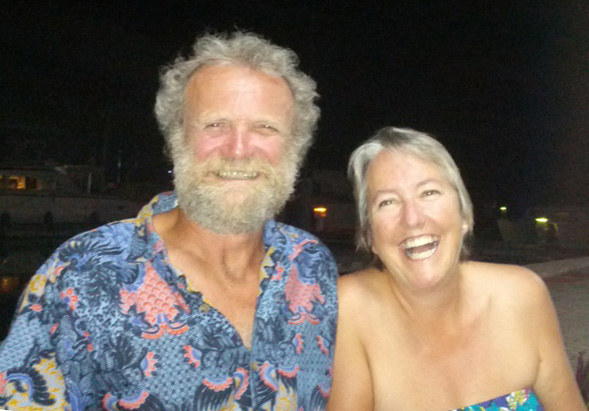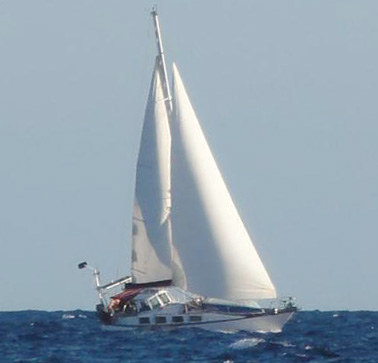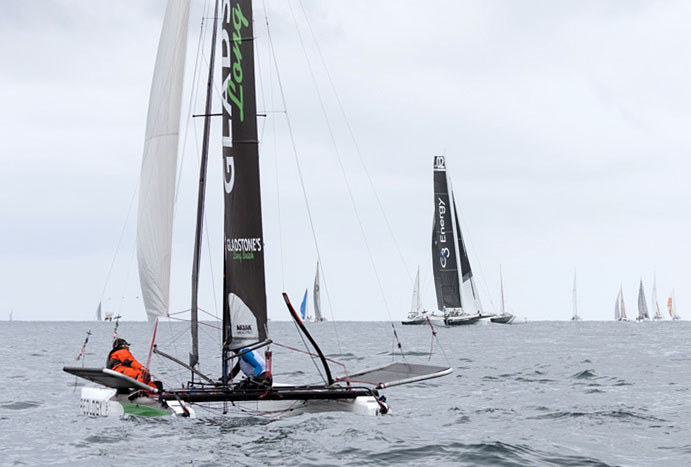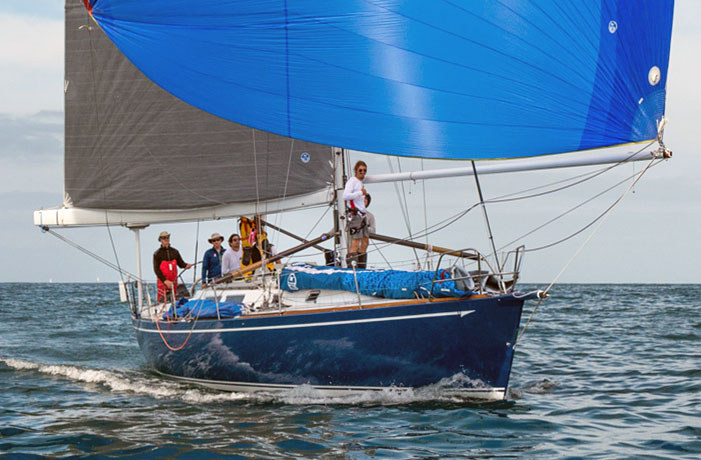
Nirvana Now Crew Tells Their Story

©Latitude 38 Media, LLC
As reported earlier, Pacific Puddle Jumpers Randy and Dawn Ortiz were forced by circumstance to abandon their Canadian-flagged S&S 42 Nirvana Now on April 8, after rescuers Bob and Mona Jankowski of the North Carolina-based Caliber 40 Continuum arrived on the scene, roughly 1,200 miles from the first possible landfall. Now safe in Papeete, Tahiti considering their options, Randy and Dawn emailed us a full report on the tragedy, which we have excerpted here:
"On the 8th of April Nirvana Now sank to the bottom of the South Pacific Ocean at latitude 07°54’ S, longitude 119°11’ W in a section of ocean farther from land than anywhere else on earth, due to damages from the heavy seas we had experienced for over a week.
"After contacting the Continuum through the Seafarer’s Ham radio network, Bob and Mona sailed hard to weather for almost two days to our rescue as we floated disabled. Due to their efforts and skill we were able to transfer safely to Continuum, and be carried to the French Marquesas, as the boat that had brought us so much joy for the 18 years we owned her settled beneath the waves."

©Latitude 38 Media, LLC
The blow-by-blow account: "Afternoon of April 6: I noticed that the forestay was loose. . . Inspection showed that the deck where the forestay attaches had started to part from the hull. We attributed this to the state of the sea over the last three days, which had been a 2- to 3-meter swell at a period of 3-5 seconds."
In order to reduce strain on the forestay, they steered a downwind course toward Nuku Hiva. After observing water accumulating in the bilge, apparently from the deck separation at the bow, they contacted the SSB Seafarer’s Net on 14.300 Mhz and explained to W3ZU Fred that their situation was critical. With the net controller’s assistance, Continuum was requested to alter course toward Nirvana Now‘s track.
"0410: A large wave came up behind us and slammed the rudder over, breaking the steering quadrant and separating from the hull the internal structure of the boat where the steering cable pulleys attach on the starboard side. We contacted W3ZU Fred and asked him to relay a mayday message to the Coast Guard that our situation had deteriorated and that we needed assistance. We then set up the emergency tiller system so we could maintain the boat in a hove-to arrangement to maintain stability. . .
"April 7, Pre-dawn: A large wave struck the rudder and broke the emergency steering linkages and the rudder started to swing free to its stops, pounding the hull of the boat."
After sunrise, Randy and Dawn lowered the main and laid out their sea anchor in order to keep the bow into the wind and seas to protect it from further damage. In addition to water ingress from the bow, leaks had started from the rudder support due to the force of the rudder striking the hull.
"Throughout the day 2- to 3-meter waves continued to slam the rudder into the bottom of the boat as the rudder stops were damaged. We rigged a line from the midship mooring cleats then aft around the rudder to reduce the movement of the rudder and the damage it was imparting to the hull.
"We were informed by the Seafarer’s Net that the S/Y Athos of London had been diverted by RCC Alameda and was on a course to our location, but would arrive after Continuum.
". . . Unfortunately Athos did not have an SSB radio on board, so we were unable to communicate with her until they were within sight, after we boarded Continuum, and then by using the VHF radio which we both had."
On April 8 at 1500 UTC time, Continuum arrived and Nirvana Now‘s crew managed to launch their dinghy and rig their outboard despite the sea conditions.
"We loaded the dinghy with our documents and a few personal belongings and transferred to the Continuum successfully due to their seamanship skills and bravery in the rough seas. We left Nirvana Now sinking at position 07 54’ S, 119 11’ W."
The megayacht Athos of London arrived about two hours later. It was decided that the Ortizes would stay aboard Continuum, rather than risk another mid-ocean transfer. On April 20, Continuum made landfall in the Marquesas with two unanticipated passengers aboard.
"I would like to express my sincere gratitude for the efforts of RCC Alameda and their radio watch keepers for their irreplaceable efforts.
"Bob and Mona Jankowski on the Continuum willingly endured great hardship as they motorsailed 40 hours into strong winds and large seas while standing watches of two hours on/two hours off to enable them to reach us before we sank. The two-hour watch routine made possible the radio contact schedule of every two hours which kept them informed of our position as we drifted disabled. It was a great morale booster to us to be to talk to our saviors on a regular basis.
"I would like to impress upon all that it was the communications allowed us through the SSB radio giving us access to the land-based Ham networks and other boats that saved our lives. With the popularity and attributes of satellite phones increasing I think it is still prudent for all persons voyaging offshore to be skilled in the use of the SSB radio. We will miss the boat that gave us so much joy for 18 years."
— Randoll N Ortiz, owner/captain, Nirvana Now
Newport to Ensenada Race
H.L. Enloe’s ORMA 60 trimaran Mighty Merloe slipped into Ensenada minutes before dawn on Saturday at 5:55:35 to secure Best Elapsed Time honors at the 68th annual Newport to Ensenada International Yacht Race. Last year’s first finisher, Tom Siebel’s MOD70 trimaran Orion, came in second, crossing the finish line in the light of day at 6:24:29 a.m.

By 8:00 a.m., the masts of the sleds and maxis could be seen peeking above the horizon. They crept in slowly, along with a bank of clouds that had been hovering offshore during the night. A group of five maxis and Fast 50s clustered together to finish only seconds apart. The breeze picked up at 10:00 a.m., giving a welcome push to the remaining competitors.

On Friday, the start may have looked like a raft-up from afar, as early morning showers had put a damper on the wind. However, within the fleets a lot of jockeying for position was going on while the various classes drifted toward the start line. By 1:00 p.m. the entire 205-boat fleet was headed for the dark gray horizon in search of wind.
Nineteen boats called in during the night to drop out of the race, including last year’s overall winner, Pete Melvin’s 8.5-meter trimaran Mama Tried.
We’ll have more in the June issue of Latitude 38.
Near-Hurricane Winds Ravage Yacht Race
If you think it was windy on San Francisco Bay, you should have been in Mobile Bay, Alabama. During the 57th running of the Dauphin Island Race, an unexpected storm packing near-hurricane-force winds came up so suddenly that some of the roughly 150 competing boats didn’t even have time to reef.
The Coast Guard reports that 10 boats were capsized or otherwise incapacitated when the 60-knot storm entered Mobile Bay at roughly 4:30 p.m. Saturday with steep seas up to 10 feet high. Three of those boats were registered in the regatta, which drew around 150 entries. Two mariners are confirmed dead and four others are still missing, not all of whom were racing.
Video by Joshua Edwards
Much like San Francisco Bay’s annual 20-mile Great Vallejo Race, the 18-mile Dauphin Island Race is one-directional, beginning in northern Mobile Bay and ending at Dauphin Island Bridge, which connects a narrow causeway to Dauphin Island, a barrier island lying four miles off the mainland. Many boats typically raft up and overnight there, prior to a return race on Sunday.
Randy Rutledge and Rhonda Gilreath were approaching the finish line in their 23-ft sloop when the storm struck, capsizing and sinking their boat. "It was just unbelievable how high the waves were," said Gilreath said. They thought they would drown, but they were eventually rescued after two hours in the water.
This is one instance where race organizers might take comfort that their fleet size has shrunk. Prior to Hurricane Katrina in 2005, the Dauphin Island Race used to draw more than 300 entries, and was once the largest point-to-point race in the country — a status that the Vallejo Race also once held.
Although this event is far beyond our normal ‘beat,’ we thought it important to bring this to your attention, if for no other reason than to serve as yet another reminder to have your emergency procedures well practiced — including reefing in a hurry.
